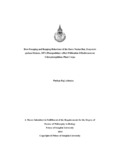Please use this identifier to cite or link to this item:
http://archive.nnl.gov.np:8080/handle/123456789/408| Title: | How foraging and ranging behavior of the dawn nectar bat, Eonycteris spelaea Dobson, 1871 (Pteropodidae) affect pollination effectiveness on Chiropterophilous plant crops |
| Authors: | Acharya, Pushpa Raj |
| Keywords: | Eonycteris spelaea Dawn bat Cross pollination Chiropterophilous |
| Issue Date: | 21-Dec-2017 |
| Abstract: | The dawn bat, Eonycteris spelaea, has long been recognized as an important pollinator of chiropterophilous plants in SE Asia, particularly of cultivated crops like durian, Durio zibethinus Murr. and Parkia speciosa Hassk. and P. timoriana dc.Merr. The pollination biology of these plants showed that they are highly or exclusively self incompatible and require cross pollination for fruit set. However, there was no detailed study of how and why Eonycteris spelaea is an effective pollinator of such crops. This study described the size of the home-range and foraging areas of E. spelaea and the feeding movements and tree visitation behaviour of this bat at durian and Parkia flowering patches in managed habitats. Radiotracking revealed that E. spelaea travelled up to 17.9 km from the cave each night to their feeding grounds. They commuted directly to the patchy food sources across the fragmented habitat and each individual confined their foraging at the known foraging areas round the nights and upto four months with strong fidelity to the feeding sites. While foraging, they visited multiple conspecific trees repeatedly and frequently throughout the foraging night. During each visit, the bats deposited a number of conspecific pollen grains on the stigma of durian and Parkia flowers. Eonycteris spelaea comprises 80 to 90 percent of flower visiting bats captured in durian orchards and Parkia patches. High visitation frequency, continuous inter-tree movement when foraging and the evidence of conspecific pollen depostion by this abundant pollinator determines their effectiveness in pollinating the crops. High mobility to forage at wide range of disturbed and undisturbed habitats such as human houseyards, scattered fruit orchards including agroforests and natural forest are the beneficial behavioural traits of E. spelaea to pollinate the crops in human occupied fragmented habitats. In addition, this study also revealed differences in the time spent foraging between individuals of different sexes and reproductive status. The short foraging period of mature males is characteristic of harem forming bats and mature females had a significantly longer foraging period, which reflects the nergetic demands of pregnancy and lactation. This study confirms that E. spelaea is capable of pollinating crops in a patchy agricultural landscape as well as native plants in fragmented forests more distant from the roost cave. Durian trees provide an ephemeral food resource to this nectar bat due to its seasonal flowering. Mixed-cropping of durian, Parkia, banana and other chiropterophilous trees like Oroxylum indicum, Ceiba pentandra and Bombax ceiba are recommended to ensure food is available to E. spelaea throughout the year. Protection of existing E. spelaea cave colonies across Southeast Asia is recommended since it can secure the production of durian and Parkia which contributes millions of dollars a year to support the livelihood of farmers across the region. |
| Description: | A Thesis submitted in fulfillment of the requirements for the Degree of Doctor of Philosophy in Biology, Prince of Songkla University, 2014. |
| URI: | http://103.69.125.248:8080/xmlui/handle/123456789/408 |
| Appears in Collections: | 600 Technology (Applied sciences) |
Files in This Item:
| File | Description | Size | Format | |
|---|---|---|---|---|
| Pushpa Thesis_Turniton.pdf | 2.65 MB | Adobe PDF |  View/Open |
Items in DSpace are protected by copyright, with all rights reserved, unless otherwise indicated.